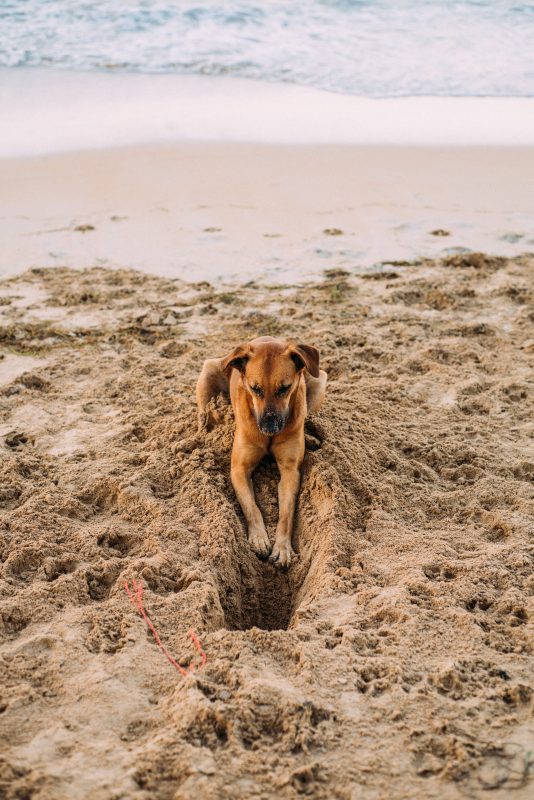Most dog owners have come to know, and sometimes dread, the tell-tale sounds of digging (whether it’s inside the house or out) and most of us have pretty firm views on our dogs digging for Australia through the hall carpet! Over the years, many of us have had the joy of living with a number of dogs, and while all dogs like to dig at some time, not all of them do it inside and not all of them do it all of the time — so why do they do it and what can we do to stop it, if it’s become a problem?

Although it may seem counter-intuitive, it’s probably easier to deal with what to do about dogs digging if we can identify why they’re doing it in the first place: and the reasons can be quite varied.
Firstly, (and this might not always be the obvious cause) always make sure that your dog has a plentiful supply of water as, if water is not available for any prolonged period, a dog’s natural instinct would be to dig to access it.
Dogs can be very territorial, and the bottom of a dog’s paws release an individual scent that is uniquely identifiable to other dogs. The release of this scent is encouraged by scratching at a resilient surface, whether that is sand on a beach, earth or mud in the garden, or your new sitting room carpet. Because this action allows the dog to lay claim to a territory, he or she may be even more keen to make their mark on a new carpet which is still virgin territory in regard to any other dog’s scent.
Some digging in the carpet can be explained by the dog searching out a hidden or elusive crumb that still smells enticing or, in a carpet that has seen some traffic over the years, there may still be a residual scent from another dog and your dog feels that it is necessary to investigate it more fully. Other interesting smells may encourage your dog to dig before circling several times if he feels that this would be a good place to lie down and both the digging and the circling are innate behavioural approaches to plumping up the bedding before lying in that space.
In some cases, indoor digging may be an extension of the normal behaviour a dog would exhibit outside if excited or frustrated by something that he has seen. Watching next door’s cat parading through the garden might well excite and frustrate your dog and digging would be a normal behaviour for a dog to exhibit outdoors if its prey had escaped down a hole or up a tree. In the world of dogs, barking and digging are normal reactions to prey that has escaped them and should be seen as displacement activity and certainly not something designed to annoy humans.
Of course, over thousands of years of interaction, dogs have developed an amazing ability to read our faces and react to our human reactions and some dogs will be happy even to receive a reprimand if that ensures that they have your attention for a few minutes. If you are looking after a dog for someone else, digging inside or outside could indicate separation anxiety, which, if persistent, should prompt a discussion with your veterinary surgeon. In other cases, digging may simply be a way of getting rid of excess energy.
What can we do to break this cycle?
In real terms, breaking the cycle is a good description of what we really need to do and to achieve that requires a change in behaviour from the dog’s human too. Left to its own devices, the dog may find such displacement activity either comforting or otherwise rewarding and both these reactions will encourage habit forming that becomes difficult for us to stop. When the dog is digging inside, make a noise – maybe using a clicker or whistle, clapping your hands gently or some other non-threatening and not-scary noise that attracts the dog’s attention. This will enable you to clearly indicate that digging is not acceptable and to revert to basic training mode where you call the dog to you and, through positive enhancement and reward, encourage him to go through the trained behaviours you have already worked on such as “sit”, “stay”,” lie down” etc., each accompanied by praise and a reward. The second step is to provide an alternative outlet for his excitement and energy such as a favourite toy and especially an activity toy that the dog needs to work on to get a further reward. Alternatively, once you have indicated that digging is not okay you can break the cycle by taking your dog to another room or out for a walk – showing that other interaction can be just as much fun.
Digging outside can have very different causes ranging from a search for food or prey (where they see or hear insects or other small mammals on the surface or even underground) to a need to lie down comfortably, or to rediscover old buried bones, or simply a desire to escape.
We need to remember that hunting or escapology are natural and highly rewarding activities for some dogs so simply shouting at or telling your dog off for digging is unlikely to have any effect at all unless accompanied by positive reinforcement of an alternative cue, as discussed above.
If, in hot weather, your dog is digging to access the cooler earth or sand that lies a few inches down, then providing shade for him to lie in and encouraging him to remain in the shade with a rewarding distraction may help to break the pattern of behaviour.
The desire to escape may have more complex roots and could indicate a need to get to something such as a bitch on heat somewhere in the vicinity, or away from something which could involve other situations, people or animals in the house. You can try ‘digging in’ chicken wire along the fence to a depth of several inches, or placing barriers or large rocks, which can help to deter the Houdinis among our canine friends but will not address the causes. It may be that you will need to seek the help of an animal behaviourist to better understand the root causes and how best to address them.
Some dogs just like to dig for fun. Like us, they find inactivity to be boring while physical exertion can be rewarding and the sensation of displacing earth, stones, sand and roots may be seen by your dog as a sufficiently pleasurable activity to be undertaken whenever there is no ready alternative to provide sufficient distraction. Once this becomes a routine habit, the repetitive nature of the activity becomes rewarding in itself and the whole cycle can be more difficult to break. Leaving your dog unsupervised while outside may be part of the problem and some owners have provided their dogs with activity areas where digging is allowed, although many dog owners would question whether their dog could easily distinguish where digging was allowed and where it wasn’t.
In the end, no matter how much we love our dogs and value them as members of the family, they like to have fun just as we do and while sewing, knitting or playing golf might be our chosen way of relaxing, for many dogs, digging is just great fun. If we want them to stop, the only sure way is to distract them with some other activity and preferably with one that involves being with us. Stopping what we are doing to take the dog for a tiring walk may not be convenient or even possible on some occasions but providing an alternative to digging with an activity toy or chew may simply buy you time to make that walk possible a little while later.


